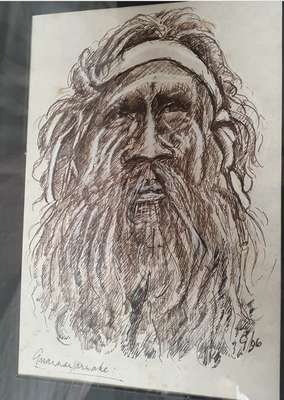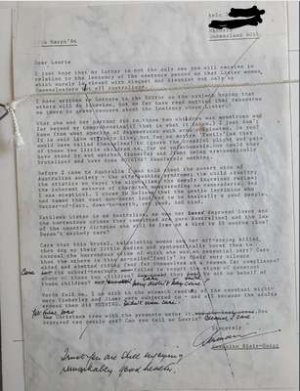Unlocking the mystery: Man unearths ‘disturbing’ message in op shop sketch
By
Seia Ibanez
- Replies 4
Content warning: This article mentions violence, child abuse, and death, which may be distressing for some readers. Discretion is advised.
It's not every day that a piece of artwork reveals a hidden layer of history, especially one as dark and unsettling as the discovery made by a man who stumbled upon a disturbing letter concealed behind a seemingly innocuous sketch.
This tale is a stark reminder that sometimes, the true stories behind second-hand treasures can be more sinister than we could ever imagine.
The unsuspecting shopper shared on social media that he had found the framed drawing of an Indigenous man at an op-shop
The portrait, which depicted the Aboriginal man with long hair, a beard, and traditional face paint, had been a part of the family's dining room decor for over a year.

It was only when the family decided to take it down for renovations that they uncovered the hidden letter.
Dated March 1996, the handwritten letter was penned by Germaine Blair-Quigg, a woman who seemed to fervently advocate for harsher penalties for violent crimes.
The letter, which contained corrections and notes in the margins, was a draft intended for a journalist.
It expressed Blair-Quigg's outrage over the lenient sentence given to Kathleen Lister, who was implicated in the gruesome murders of her two children by her husband, Dexter Wilkinson, in the rural town of Bell, Queensland.
'What she and her partner did to those two children was monstrous and far beyond my comprehension,' Blair-Quigg wrote.
'Before I came to Australia, I was told about the covert side of Australian society, the wife bashing/syndrome; the child cruelty; the statistics on rape; the alcoholism: the deeply ingrained racism; the inherent weakness of character masquerading as camaraderie.
'And I was sceptical. I chose to believe that the gentle larrikins who had tamed that vast sunburnt land had to be basically good people. Matter-of-fact, down-to-earth, good. And kind.'
The Supreme Court of Queensland's account of the case was nothing short of horrific.
The court documents detailed the harrowing events that led to the deaths of Jimmy, aged 11, and Kimberley, aged 9, just before Christmas in 1994.
Wilkinson, described as an 'extremely violent, mentally unstable man,' had subjected the entire household to physical abuse, with the children bearing the brunt of his wrath.
The court documents revealed that on 22 December 1994, Wilkinson violently attacked Jimmy, throwing him around the house, causing him to hit his head on the floor and lose consciousness.
Despite this, Jimmy wasn't given any medical help and tragically died from his injuries the next day.
Lister claimed she tried to get medical assistance for Jimmy but was stopped by Wilkinson, who instead brought alcohol and cigarettes.
That same night, Lister helped her husband bury Jimmy in a grave.
The following day, Kimberley suffered a similar fate.
Wilkinson ordered her to do a task but became enraged when she didn't do it quickly enough.
He threw her to the ground and kicked her in the stomach, causing her immediate death.
‘Lister wiped Kimberley's face and tried to revive her, but there was no pulse and no response,' the court heard.
‘Wilkinson said, "Leave the f*****g b***h where she is, she got what she deserved. She should have been the one to go first."’
‘According to Lister, Wilkinson hated Kimberley and called her "the devil's child",’ it added.
The crimes only became known when Lister accidentally talked about them to a friend in February 1995.
This happened shortly after Wilkinson, who never faced consequences for his actions, died in a car crash.
The friend then told a pastor, who spoke to Lister, who admitted everything to the police.
Lister's complicity in the aftermath of the murders, her failure to seek help, and her efforts to conceal the crimes with Wilkinson were laid bare.
'You made no attempt whatsoever to leave him and report the matter after the children died,’ the judge said.

'You continued to cover up in every respect with him until the stage when he could never have been apprehended because of his death and indeed some time afterwards.’
'The inference is that it would probably have continued if he was not killed.'
Despite her claims of being dominated by Wilkinson and showing remorse, the judge sentenced her to a term of two years for manslaughter and nine years for murder, with a minimum of five years to be served before she was eligible for parole.
The whereabouts of Kathleen Lister, who would now be 75 years old, remain a mystery, adding another layer of intrigue to this already chilling story.
Thrift shopping from op shops can be quite a discovery. From rare collectibles to designer wear at a fraction of the cost, the possibilities are endless.
But sometimes, the surprises that come with these second-hand items can be downright bizarre, even unsettling.
One such incident recently left a woman in shock. She had purchased a porcelain doll from a thrift store for $2, hoping it might be a hidden gem.
Little did she know, the doll was hiding something far from precious inside its hollow head. You can read here to find out more.

What do you think about this story, members? Let us know in the comments below.
It's not every day that a piece of artwork reveals a hidden layer of history, especially one as dark and unsettling as the discovery made by a man who stumbled upon a disturbing letter concealed behind a seemingly innocuous sketch.
This tale is a stark reminder that sometimes, the true stories behind second-hand treasures can be more sinister than we could ever imagine.
The unsuspecting shopper shared on social media that he had found the framed drawing of an Indigenous man at an op-shop
The portrait, which depicted the Aboriginal man with long hair, a beard, and traditional face paint, had been a part of the family's dining room decor for over a year.

A shopper bought this sketch in an op shop, but they found a disturbing letter behind it. Credit: @Investforthenest / Reddit
It was only when the family decided to take it down for renovations that they uncovered the hidden letter.
Dated March 1996, the handwritten letter was penned by Germaine Blair-Quigg, a woman who seemed to fervently advocate for harsher penalties for violent crimes.
The letter, which contained corrections and notes in the margins, was a draft intended for a journalist.
It expressed Blair-Quigg's outrage over the lenient sentence given to Kathleen Lister, who was implicated in the gruesome murders of her two children by her husband, Dexter Wilkinson, in the rural town of Bell, Queensland.
'What she and her partner did to those two children was monstrous and far beyond my comprehension,' Blair-Quigg wrote.
'Before I came to Australia, I was told about the covert side of Australian society, the wife bashing/syndrome; the child cruelty; the statistics on rape; the alcoholism: the deeply ingrained racism; the inherent weakness of character masquerading as camaraderie.
'And I was sceptical. I chose to believe that the gentle larrikins who had tamed that vast sunburnt land had to be basically good people. Matter-of-fact, down-to-earth, good. And kind.'
The Supreme Court of Queensland's account of the case was nothing short of horrific.
The court documents detailed the harrowing events that led to the deaths of Jimmy, aged 11, and Kimberley, aged 9, just before Christmas in 1994.
Wilkinson, described as an 'extremely violent, mentally unstable man,' had subjected the entire household to physical abuse, with the children bearing the brunt of his wrath.
The court documents revealed that on 22 December 1994, Wilkinson violently attacked Jimmy, throwing him around the house, causing him to hit his head on the floor and lose consciousness.
Despite this, Jimmy wasn't given any medical help and tragically died from his injuries the next day.
Lister claimed she tried to get medical assistance for Jimmy but was stopped by Wilkinson, who instead brought alcohol and cigarettes.
That same night, Lister helped her husband bury Jimmy in a grave.
The following day, Kimberley suffered a similar fate.
Wilkinson ordered her to do a task but became enraged when she didn't do it quickly enough.
He threw her to the ground and kicked her in the stomach, causing her immediate death.
‘Lister wiped Kimberley's face and tried to revive her, but there was no pulse and no response,' the court heard.
‘Wilkinson said, "Leave the f*****g b***h where she is, she got what she deserved. She should have been the one to go first."’
‘According to Lister, Wilkinson hated Kimberley and called her "the devil's child",’ it added.
The crimes only became known when Lister accidentally talked about them to a friend in February 1995.
This happened shortly after Wilkinson, who never faced consequences for his actions, died in a car crash.
The friend then told a pastor, who spoke to Lister, who admitted everything to the police.
Lister's complicity in the aftermath of the murders, her failure to seek help, and her efforts to conceal the crimes with Wilkinson were laid bare.
'You made no attempt whatsoever to leave him and report the matter after the children died,’ the judge said.

Germaine Blair-Quigg wrote the letter to a journalist about imposing harsher penalties on Kathleen Lister. Credit: @Investforthenest / Reddit
'You continued to cover up in every respect with him until the stage when he could never have been apprehended because of his death and indeed some time afterwards.’
'The inference is that it would probably have continued if he was not killed.'
Despite her claims of being dominated by Wilkinson and showing remorse, the judge sentenced her to a term of two years for manslaughter and nine years for murder, with a minimum of five years to be served before she was eligible for parole.
The whereabouts of Kathleen Lister, who would now be 75 years old, remain a mystery, adding another layer of intrigue to this already chilling story.
Thrift shopping from op shops can be quite a discovery. From rare collectibles to designer wear at a fraction of the cost, the possibilities are endless.
But sometimes, the surprises that come with these second-hand items can be downright bizarre, even unsettling.
One such incident recently left a woman in shock. She had purchased a porcelain doll from a thrift store for $2, hoping it might be a hidden gem.
Little did she know, the doll was hiding something far from precious inside its hollow head. You can read here to find out more.
Key Takeaways
- A man discovered a disturbing letter detailing a historic child murder case hidden behind a sketch he bought from an op shop.
- The letter condemned the light sentencing of Kathleen Lister, an accessory to the murder of her two children by her husband, Dexter Wilkinson, in the small town of Bell, Queensland.
- Kathleen Lister was sentenced to jail for her role in the cover-up of the murders, and her current whereabouts are unknown.
- The letter was likely authored by Germaine Blair-Quigg, who had written to newspapers criticising lenient sentences for violent crimes.







